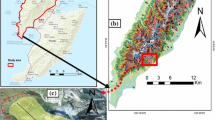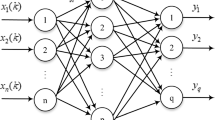Abstract
In-depth quantitative studies regarding the nonlinear development laws of a region and the calculation of construction land area (CLA) and weight coefficients of different influencing factors are of great significance for establishing the developmental change model of a region. In this study, a novel calculation method using correlation coefficients was introduced. First, models of three neural network algorithms, namely, back propagation neural network (BPNN), grey model neural network (GMNN), and generalised regression neural network (GRNN), were constructed. Key attention was given to improvement of the BPNN. The correlation laws of different influencing factors in a region and the CLA were discovered and extracted using these three models. The coefficient of determination and coefficient of variation were applied to verify the validity of the simulation results for each neutral network algorithm model. The mean absolute error and root mean square error of the three algorithm models were calculated to select the neutral network algorithm model with the highest accuracy. Subsequently, the mean impact value algorithm was added to the selected algorithm model to calculate the weight coefficients for the different relevant factors. The calculated results were compared with the weight values of influencing factors, which were calculated using the analytic hierarchy process, thus forming a set of calculation methods for a more accurate judgement of the influencing factors and weight coefficients of CLA. In this study, the correlations between the influencing factors and CLA were calculated using the proposed method via a case study. The calculated results of the proposed method conformed well to the practical situation in Ya’an City, indicating that the proposed method is worthy of promotion and practice.







Similar content being viewed by others
Data availability
Not applicable.
Code availability
Not applicable.
References
Arabameri A et al (2020) A novel ensemble computational intelligence approach for the spatial prediction of land subsidence susceptibility. Sci Total Environ 726:138595
Avashia V, Garg A (2020) Implications of land use transitions and climate change on local flooding in urban areas: An assessment of 42 Indian cities. Land Use Policy 95
Biancofiore F, Busilacchio M, Verdecchia M, Tomassetti B, Aruffo E, Bianco S, Di Tommaso S, Colangeli C, Rosatelli G, Di Carlo P (2017) Recursive neural network model for analysis and forecast of PM10 and PM2.5. Atmos Pollut Res 8:652–659
Che Z-G et al (2011) Feed-forward neural networks training: a comparison between genetic algorithm and back-propagation learning algorithm. Int J Innov Comput Inf Control 7(10):5839–5850
Chen XP (2017) Influence factors of material parameters of police protection equipment based on AHP-fuzzy algorithm. Agro Food Ind Hi Tech 28(1):1982–1986
Chen T (2018) Fitting an uncertain productivity learning process using an artificial neural network approach. Comput Math Organ Theory 24(3):422–439
Closson D et al (2005) Subsidence and sinkhole hazard assessment in the southern Dead Sea area, Jordan. Pure Appl Geophys 162(2):221–248
Cobourn WG, Dolcine L, French M, Hubbard MC (2000) A comparison of nonlinear regression and neural network models for ground-level ozone forecasting. J Air Waste Manag 50:1999–2009
da Silva LEB, Wunsch DC (2017) Validity index-based vigilance test in adaptive resonance theory neural networks. IEEE Symposium Series on Computational Intelligence (SSCI) 2017:1–8. https://doi.org/10.1109/SSCI.2017.8285206
Gardner MW, Dorling SR (1998) Artificial neural networks (the multilayer perceptron) —A review of applications in the atmospheric sciences. Atmos Environ 32:2627–2636
Gebhardt S, Nguyen LD, Kuenzer C (2012) Mangrove ecosystems in the mekong delta – Overcoming uncertainties in inventory mapping using satellite remote sensing data. In: Renaud F, Kuenzer C (eds) The Mekong Delta System. Springer, Dordrecht. https://doi.org/10.1007/978-94-007-3962-8_12
Hao HM, Ren ZY (2009) Land Use/Land Cover Change (LUCC) and eco-environment response to LUCC in farming-pastoral zone, China. Agric Sci China 8(1):91–97
Haykin SS, Haykin SS, Haykin SS, Haykin SS (2009) Neural networks and learning machines, vol 3. Pearson Education, Upper Saddle River
Li H-Z et al (2012) Improving the accuracy of DFT calculation for Homolysis bond dissociation energies of Y-NO bond via back propagation neural network based on mean impact value. Chem J Chin Univ-Chinese 33(2):346–352
Li XX et al (2016) Remote sensing of the surface urban heat island and land architecture in Phoenix, Arizona: Combined effects of land composition and configuration and cadastral-demographic-economic factors. Remote Sens Environ 174:233–243
Lin JW et al (2018) Determining neuronal number in each hidden layer using earthquake catalogues as training data in training an embedded back propagation neural network for predicting earthquake magnitude. IEEE Access 6:52582–52597
Liu DY, Zheng XQ, Zhang CX, Wang HB (2017) A new temporal– spatial dynamics method of simulating land-use change. Ecol Model 350:1–10
Ma D, Zhang F, Bull DR (2020) Gan-based effective bit depth adaptation for perceptual video compression. 2020 IEEE International Conference on Multimedia and Expo (ICME), 2020, pp 1–6. https://doi.org/10.1109/ICME46284.2020.9102865
Minh HVT et al (2019) Monitoring and mapping of rice cropping pattern in flooding area in the Vietnamese Mekong Delta Using Sentinel-1A Data: A case of an Giang Province. ISPRS Int J Geo Inf 8(5)
Nguyen MD, Pham BT, Tuyen TT, Yen H, Phan H, Prakash I, Vu TT, Chapi K, Shirzadi A, Shahabi H (2019) Development of an artificial intelligence approach for prediction of consolidation coefficient of soft soil: A sensitivity analysis. Open Constr Build Technol J 13
Park S et al (2013) Landslide susceptibility mapping using frequency ratio, analytic hierarchy process, logistic regression, and artificial neural network methods at the Inje area, Korea. Environ Earth Sci 68(5):1443–1464
Pham BT, Bui DT, Prakash I, Dholakia MB (2017) Hybrid integration of Multilayer Perceptron Neural Networks and machine learning ensembles for landslide susceptibility assessment at Himalayan area (India) using GIS. Catena 149, 52–63. https://doi.org/10.1016/j.catena.2016.09.007
Phiri D et al (2019) Long-term land cover change in Zambia: An assessment of driving factors. Sci Total Environ 697
Ren C et al (2014) Optimal parameters selection for BP neural network based on particle swarm optimization: A case study of wind speed forecasting. Knowl-Based Syst 56:226–239
Roy J, Saha S (2019) Landslide susceptibility mapping using knowledge driven statistical models in Darjeeling District, West Bengal, India. Geoenviron Disasters 6(1):11
Roy J, Saha S (2019b) GIS-based gully erosion susceptibility evaluation using frequency ratio, cosine amplitude and logistic regression ensembled with fuzzy logic in Hinglo River basin, India. Remote Sens Appl Soc Environ 15:100247
Sadeghi V et al (2013) A new model for automatic normalization of multitemporal satellite images using Artificial Neural Network and mathematical methods. Appl Math Model 37(9):6437–6445
Tien Bui D, Tuan TA, Klempe H, Pradhan B, Revhaug I (2015) Spatial prediction models for shallow landslide hazards: a comparative assessment of the efficacy of support vector machines, artificial neural networks, kernel logistic regression, and logistic model tree. Landslides: 1–18 https://doi.org/10.1007/s10346-015-0557-6
Tran H, Tran T, Kervyn M (2015) Dynamics of land cover/land use changes in the Mekong Delta, 1973–2011: A remote sensing analysis of the Tran Van Thoi District, Ca Mau Province, Vietnam. Remote Sens 7:2899–2925
Valipour M et al (2013) Comparison of the ARMA, ARIMA, and the autoregressive artificial neural network models in forecasting the monthly inflow of Dez dam reservoir. J Hydrol 476:433–441
Veettil BK et al (2019) Changes in mangrove vegetation, aquaculture and paddy cultivation in the Mekong Delta: A study from Ben Tre Province, southern Vietnam. Estuar. Coast. Shelf Sci 226
Viedma O et al (2017) Recent land-use and land-cover changes and its driving factors in a fire-prone area of southwestern Turkey. J Environ Manage 197:719–731
Wang L et al (2015) Back propagation neural network with adaptive differential evolution algorithm for time series forecasting. Expert Syst Appl 42(2):855–863
Wang SH et al (2017). Hearing loss detection in medical multimedia data by discrete wavelet packet entropy and single-hidden layer neural network trained by adaptive learning-rate back propagation. Adv Neural Netw, Pt Ii. Cong F, A. Leung Q Wei 10262: 541–549
Witek-Krowiak A et al (2014) Application of response surface methodology and artificial neural network methods in modelling and optimization of biosorption process. Biores Technol 160:150–160
Xie L et al (2008) Ship equipment fault grade assessment model based on back propagation neural network and genetic algorithm. 2008 International Conference on Management Science & Engineering. H Lan 211–218
Yu JQ et al (2019) Land use efficiency and influencing factors of urban agglomerations in China. Land Use Policy 88
Zhao JS et al (2016) A study of the system dynamics coupling model of the driving factors for multi-scale land use change. Environmental Earth Sciences 75(6)
Zhao X et al (2018) Land-Use Spatio-Temporal Change and Its Driving Factors in an Artificial Forest Area in Southwest China. Sustainability 10(11)
Funding
The work is funded by National Key R&D Program of China (2018YFD1100804).
Author information
Authors and Affiliations
Contributions
Not applicable.
Corresponding author
Ethics declarations
Conflicts of interest/Competing interests
Not applicable.
Additional information
Communicated by: H. Babaie
Publisher’s note
Springer Nature remains neutral with regard to jurisdictional claims in published maps and institutional affiliations.
Highlights
In this paper, A case study based on Ya’an City was performed. Key attention was given to the following aspects:
(1) How to use the machine-learning algorithm to extract laws during urban-rural development? What are the differences among the three applied machine-learning algorithms? How to realise these three algorithms? What are the optimisation and accuracy comparison methods of the three algorithms?
(2) What are the similarities and differences between the neural networks (using the MIV algorithm) and AHP in determining the weights of the variables?
(3) How to provide a universal method to determine the relative importance of influence values for other cities, towns, and villages?
Rights and permissions
About this article
Cite this article
Gao, L., Zhou, Y., Guo, K. et al. Determining the weights of influencing factors of construction lands with a neural network algorithm: a case study based on Ya’an City. Earth Sci Inform 14, 1973–1985 (2021). https://doi.org/10.1007/s12145-021-00657-8
Received:
Accepted:
Published:
Issue Date:
DOI: https://doi.org/10.1007/s12145-021-00657-8




